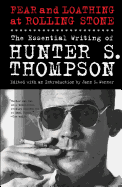
Hunter S. Thompson wrote for Rolling Stone from 1970 until his last official "dispatch" shortly before his death in 2004. In those three and a half decades, he produced what Paul Scanlon, the magazine's managing editor in the 1970s, estimates to be a total of almost half a million words, about 250,000 of which appear in this collection. From Las Vegas and Watergate to Nixon's funeral, along with whatever events struck his macabre, capricious, drug-fueled fancy, Thompson invented a new style of journalism by reporting the facts as filtered through a surreal, finely tuned sense of the Kafkaesque.
Those familiar with Thompson only by reputation may be surprised to learn how gaspingly, nonstop, laugh-out-loud funny he is. "Fear and Loathing in Elko," to take one example, is a delirious freefall through the layers of Thompson's explosive mix of fact and paranoia, allegedly recounting a road trip with Clarence Thomas involving guns, drugs, "The Judge" taking Thompson's wallet and $20,000, a suicide, near-fatal escapes, Chinese sex dolls and spray cans of black paint applied to his "wanted" vehicle. Even a genteel luncheon with Bill Clinton on the 1992 campaign trail could inspire febrile headlines for Thompson's canted imagination: "Clinton Injured in Wild Brawl with Dope Fiends: Candidate Denies Drunkenness, Cancels Bus Trip, Flees."
Appealing to readers with an appreciation for the freakish, Fear and Loathing at Rolling Stone will also introduce Thompson to a new generation of readers who will discover they, too, are demented, die-hard fans. --Judith Hawkins-Tillirson, proprietress, Wyrdhoard Books, and blogger at Still Working for Books

